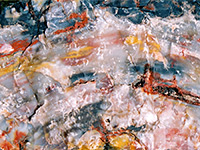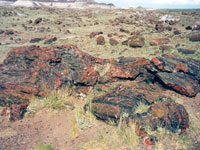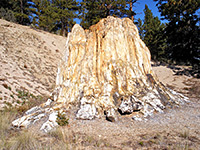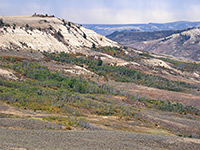Well known, publicly accessible fossil sites in the USA tend to be concentrated in the northern Great Plains states, where large areas of soft, sedimentary rocks are exposed, with little covering vegetation. The most common fossil type in the Southwest is petrified wood, and the most fruitful location is Petrified Forest National Park in northeast Arizona, near Holbrook. Here the wood is crystalline and especially colorful; beautiful hues of yellow, red and purple, unlike specimens elsewhere which are predominantly dull brown or grey. The park goes to some lengths to ensure that visitors do not take away samples, but these can be purchased from nearby shops, which sell rocks obtained from private ground just outside the park.
The fossils in the national park occur in the purplish-grey Chinle Formation, a Triassic period sandstone layer that is quite common across the Colorado Plateau and often contains petrified wood. The plateau extends from northeast Arizona over much of south Utah and smaller areas of Colorado and New Mexico, and contains several other strata that also have petrified wood including the Fruitland Formation and Kirtland Shale, both found in the San Juan Basin of northwest new Mexico. Some other petrified wood locations on the Colorado Plateau are:
Other Southwest parks and preserves featuring fossils are listed below. In general, specimens are not viewable in a natural state, as all or most have been excavated, and instead may be viewed in museums or in protected areas.
The fossils in the national park occur in the purplish-grey Chinle Formation, a Triassic period sandstone layer that is quite common across the Colorado Plateau and often contains petrified wood. The plateau extends from northeast Arizona over much of south Utah and smaller areas of Colorado and New Mexico, and contains several other strata that also have petrified wood including the Fruitland Formation and Kirtland Shale, both found in the San Juan Basin of northwest new Mexico. Some other petrified wood locations on the Colorado Plateau are:
- Escalante Petrified Forest State Park, a small preserve just outside the town of Escalante
- Wolverine Canyon and Horse Canyon, Grand Staircase-Escalante NM - along the road to Little Death Hollow
- Vicinity of Grosvenor Arch, along Cottonwood Canyon Road, Grand Staircase-Escalante NM
- Bisti, De-Na-Zin, Ash-Shi-Sle-Pah, and other locations in the San Juan Basin of northwest New Mexico
- The Paria River corridor, Grand Staircase-Escalante NM, for example around the old Pahreah townsite and the Wire Pass trailhead
- Foothills of the Straight Cliffs, west of Hole-in-the-Rock Road
- Berlin-Ichthyosaur State Park, central Nevada - several large fossils of the ichthyosaur (a dolphin-like creature)
- Cleveland-Lloyd Dinosaur Quarry, at the edge of the San Rafael Swell in central Utah - large collection of Jurassic period dinosaur fossils
- Dinosaur National Monument, Colorado/Utah - hundreds of fossilized dinosaur bones, embedded in a steep rock face near the Green River, at the center of a vast wilderness region of canyons, ridges and mesas
- Dinosaur Valley State Park - fossilized dinosaur footprints, in flat limestone layers beside the Paluxy River, towards the north edge of the Texas Hill Country
- Florissant Fossil Beds National Monument, Colorado - large petrified sequoia stumps, and pits where many smaller fossils have been excavated
- Fossil Butte National Monument, Wyoming - site of important fossil discoveries, in barren country of grassy mesas and sagebrush valleys, near Kemmerer
- Hagerman Fossil Beds National Monument, Idaho - grassy cliffs and hills bordering the Snake River, site of important Pliocene fossil discoveries
- John Day Fossil Beds National Monument - colorful outcrops of fossil-bearing sandstone in the remote, rolling, grassy hills of east Oregon
- La Brea Tar Pits, Los Angeles, California - dinosaur fossils from the Pleistocene epoch
- Tule Springs Fossil Beds National Monument - desert valley just north of Las Vegas, Nevada, where many Ice Age fossils have been unearthed
All Contents © Copyright The American Southwest | Comments and Questions | Contribute | Affiliate Marketing Disclosure | Site Map








